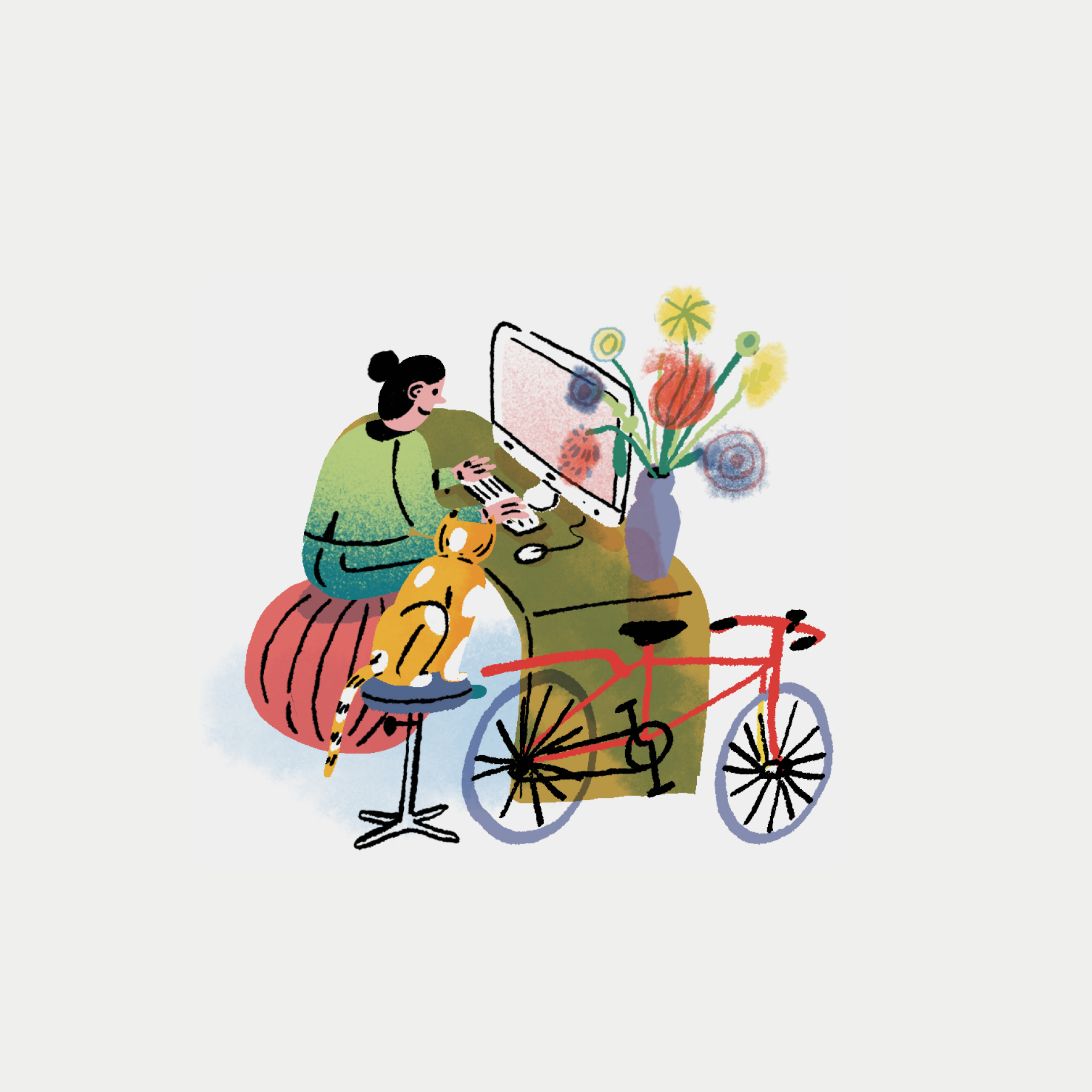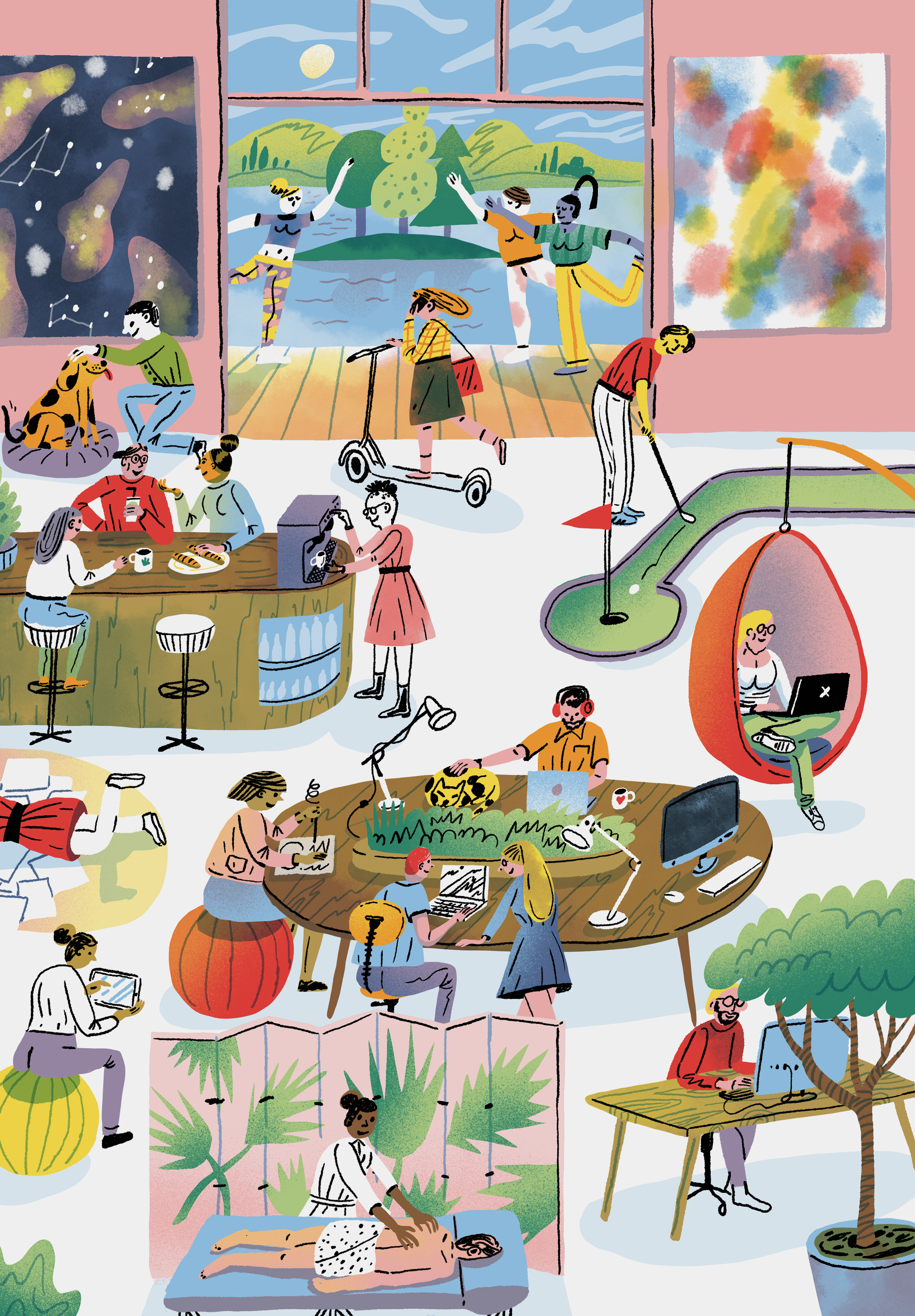We spend a big amount of our time by our desks, with our colleagues and our managers. How can we make our workplaces our happy places? We talked to two HR experts to map out the cornerstones of a happier workplace.
The average worker spends 90,000 hours at work over their lifetime — a whopping one third of their entire life. Work is what we spend a huge chunk of our days on and, paraphrasing author Annie Dillard, how we spend our days is how we spend our lives. Exactly how, what and with whom we spend our time are not a small details to be shrugged off nonchalantly. Quite the opposite: our work and our workplace have a huge effect on our mental and physical health. A full day of work can bring us feelings of stress, tiredness and sadness — but in the best case scenario, the workplace is a place of safety, innovation, fun and community.
Recognising the importance of a -positive work environment is of paramount importance, not just on an individual or organisational, but also on a societal level. According to the American Psychological Association, more than 500 billion dollars is siphoned off from the US economy solely due to workplace stress. And, with 550 million workdays lost due to stress across America, it is no wonder many American companies are turning their gaze inwards to find solutions to problems in their working culture.
On an individual level, workplace stress can be damaging to our delicate brains both in the short term as well as in the long run: it can lead to burning out and permanent changes in the way we think and feel. In addition to this, workplace stress can place a huge amount of pressure on your body. A study conducted by the Swedish Karolinska Institute revealed that leadership behaviour and heart disease in employees have a direct correlation. In short: being a bad boss could literally hurt your employees.
“We live in a fast world,” says Taru Laukkanen, Head of HR and Culture at Greenstep, and continues, “access to information has provided employees with an understanding of what’s out there. They want faster changes, less static roles and more freedom.” However, as Laukkanen points out, some of the traditional methods of leadership still have their place in the happy workplace of tomorrow. “Employees won’t cease to need structures that guide them in their work. Structures protect employees and allow contemporary freedom.” Kati Tuovinen, Head of HR Business at Greenstep agrees with Laukkanen: “Everything comes back to culture,” she states. According to Tuovinen, culture is built out of good structures and good communications, whether it’s about leadership, methods and sharing. “You need to know when and how to pass things on and when to push forward.” At their simplest, structures could consist of instructions and meeting conventions. And, although many people equate structures with unnecessary bureaucracy, both Laukkanen and Tuovinen think that structures are important when creating freer and more autonomous workplaces.

Employee satisfaction is both the cornerstone and result of a happy, healthy workplace. In a way, it can be argued to be the most valuable goal a company can meet, as it is linked to higher job performance and lower turnover in experts — happy people could generate more happiness and growth around them. In addition to this, in a world characterised by tightening competition and faster decision-making, keeping your employees happy could make or break your business. International top talent is no longer happy with run-of-the-mill management and cookie-cutter tasks.
Today, happiness at workplace is generated by freedom, encouragement and clear tasks. A bigger turnover and happier employees are surely on the top of every employer’s list — but how can we get there? How can one steer the ship towards happier waters when it comes to employees? Perhaps it isn’t about reinventing the wheel, but about something far simpler. “You don’t have to reinvent the wheel,” advises Laukkanen. For her, the most vital skill to have as an employee is the ability to listen to your community. “Find out what your people want and need. Create a space in which everyone feels free to voice their ideas and concerns,” she says.
A workplace that lets you be yourself and be honest can be liberating and profitable. The right human resources team and real efforts make the journey there a little easier. It all starts from meeting changing expectations. As both Laukkanen and Tuovinen state, the workplace experience needs to be completely modernised. It can’t be cookie-cutter business: not everyone wants the same things and it is worthwhile to try to accommodate different employees’ varying needs. Good leaders are often supported by a good human resources department, be it outsourced or internal. Then again, the responsibility has to be shared. “In my opinion, culture is for us all to create and nurture. We are all responsible for up keeping a positive, encouraging and warm working environment,” concludes Laukkanen. Although this might not be the foolproof recipe for human resources happiness, it sure is an excellent place to start from.

We wanted to take a deeper dive into workplace happiness, so we got 391 -people to answer a questionnaire on what makes them happy at work. The survey was sent to employees who occupy different positions within a variety of companies around Finland.
Where we work from can determine how much we enjoy our working days. From open offices to cubicles, work is starting to take new and unexpected physical forms. However, the survey results show that conventional ways of working still prevail. Almost all respondents to the survey from all fields, ages and roles preferred working either from a home office, in a traditional open office or a room within an office space. However, younger (18–24-year-old) respondents reported being drawn to both a quiet home office and more open, sociable and relaxed take on traditional offices, preferring a lounge space or couches to their own office rooms. Older (50–59-year-old) respondents were in contrast with their younger peers and in favour of open offices over home offices and working in their own room. Roles also affected the way respondents ranked different alternatives to workplaces: out of all of the respondents, assistants and directors preferred an open office, perhaps due to a need for fast in-person communication.

The five most important factors in creating happiness at work, as stated by all respondents, are flexible working hours and a possibility to work remotely, a good working environment, honest and open communications, opportunities for learning and development, and a feeling of being valued. Open and honest communications was stated as the most important factor in driving happiness by directors and CXOs valued open communication the most, as well as respondents who work in either small (11–20--employees) or medium-sized (201–500-employees) companies; businesses that might be on the cusp of growth or at a crossroads. Perhaps in smaller offices the need for honesty is highlighted by the inevitable closeness of the work relationships; in medium-sized companies the structures for growth are supported by honesty and openness. When it comes to interpersonal communications and relationships, CXOs and directors’ opinions diverged from the study group’s answers drastically: for C-suite seat holders, sharing ethics and values with their employer was more important than for anyone else. CXOs also, quite understandably, valued the financial stability of their workplace more than other survey-takers.
Along with financial stability of a company, the individual’s financial compensation and perks can sometimes offset the cost of long working hours and compromised ethics. Yet, a competitive salary and good perks only made the top-5 selection of specialists and CXOs. Younger respondents saw monetary compensation far less important than 31–49-year-old employees and over 60-year-old respondents. Moreover, a competitive salary and perks were seen as more important in bigger companies with over 1,000 -employees — although, for employees who work in companies with over 1,000 employees, the meaningfulness of work was more important than for others.
The study showcases the importance of building a modern, flexible workplace, in which people grow and develop. Work isn’t seen as something that merely provides financial security, but as a thing that can enrich one’s life in social, cultural and emotional ways. Honesty and the willingness to communicate with one’s colleagues, peers and managers highlights a will for real human connections in a time of digital-first. All groups that participated in the study thought that work should be meaningful. The ways in which we work and find happiness are changing — and it’s up to us all to ensure that our workplaces bring us the most happiness they possibly can.
Words: Matilda KiveläIllustration: Aart-Jan Venema

Published 03.12.2019
